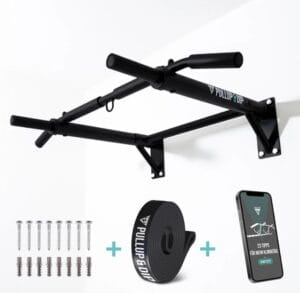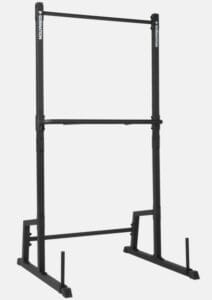Looking to level up your calisthenics game? A solid pull-up bar is one of the most important pieces of equipment you can own. Whether you’re training for your first pull-up or refining advanced skills like muscle-ups or front levers, the right bar will be your best training partner.
Pull-up bars help build upper body and core strength, improve grip, and open the door to a wide range of bodyweight exercises. From static holds to explosive reps, they’re essential for progress—no matter your level.
In this guide, we’ll break down the best pull-up bars for calisthenics, explain who they’re best for, and give you our top picks based on real-world use. We’ll cover different types of bars, their pros and cons, and what to look for before you buy. Whether you’re training at home, outdoors, or on the go, there’s an option here for you.
Table of Contents
Why a pull-up Bar is essential for calisthenics
Pull-ups, chin-ups, muscle-ups, levers, leg raises—the list goes on. A pull-up bar unlocks nearly all upper body calisthenics progressions.
Whether you’re training at home, outdoors, or in a gym, a good bar should feel stable, support your full range of motion, and match your training goals. It should give you confidence during explosive reps and strict holds alike. Grip comfort, bar diameter, and mounting style all play a role in how well a bar fits your routine. The right pull-up bar doesn’t just hold your weight—it supports your progress, rep after rep.
Types of pull-up bars
Pull-up bars come in different shapes and setups—each with its own strengths. In this guide, we’ll focus on the four most popular types for calisthenics: doorway bars, wall-mounted bars, ceiling-mounted bars, and power towers.
Each type has its place, whether you’re working out in a small apartment or building a full home gym. Below, we’ll break down the pros, cons, and ideal use cases for each one.
There are two common styles of doorway pull-up bars, each with its own pros and cons.
Telescopic bars screw directly into the doorframe. You twist them to extend and lock them tightly in place. They’re discreet and take up very little space, which makes them ideal for small rooms or shared spaces. However, they do require a strong, solid doorframe to be safe. If the frame is weak or uneven, the bar can slip during use.
Leverage-based bars hook over the top of the frame and rely on your bodyweight to create pressure. No tools or drilling needed. You can hang them up in seconds, train, and take them down just as fast. That makes them perfect if you want something portable or if you’re renting and can’t damage the walls. Just make sure your doorframe has enough clearance and isn’t too fragile.
My favorite telescopic pull-up bar
Gornation Pull-Up bar extend it: These extend and rotate into place between the sides of a doorframe.

My favorite leverage based pull-up bar
- Pullup & Dip Doorway pull-up bar: Quick to mount and unmount, with smart weight distribution that protects your doorframe while supporting solid strength work.

Looking for a stable, long-term setup? A wall-mounted pull-up bar is a serious upgrade if you’ve outgrown doorway options. Once properly installed, it feels solid under any movement—whether you’re doing strict pull-ups, explosive muscle-ups, or heavy weighted reps. That stability makes it a favorite among advanced athletes and anyone building a dedicated home gym.
Most wall-mounted bars come with multiple grip positions, letting you train wide, narrow, or neutral grip variations without switching equipment. They also tend to have a much higher weight capacity compared to portable options, which is great if you’re adding weight to your workouts.
Of course, the trade-off is that you’ll need to drill into a strong wall—ideally brick or concrete—for safe installation. And once it’s up, it’s not going anywhere. That makes it less ideal for renters or anyone who needs a portable setup.
Top Pick: Pullup & Dip Wall-Mounted Bar. This bar combines rock-solid construction with a smart, space-saving design—perfect for serious calisthenics training at home.

Ceiling-mounted pull-up bars are a great choice if you have the right setup—especially in basements, garages, or home gyms with open overhead space. By mounting the bar to the ceiling, you free up wall space and create more room to move around the bar. This is especially useful for exercises that require momentum, like muscle-ups or kipping pull-ups.
Another big advantage is the vertical clearance. Since the bar hangs from above, you can get a full range of motion without your legs hitting the floor—great for moves like toes-to-bar or front levers. It also gives you plenty of space to attach rings or resistance bands, adding even more variety to your training.
However, ceiling-mounted bars do require strong, secure overhead mounting. You’ll need to fix them into solid beams or concrete for safe use. They’re also less common than wall-mounted or doorway options, so you won’t find as many models on the market.
Top Pick: Gornation Multi Pull-Up Bar. Minimalist but built like a tank. Perfect for high-level calisthenics and easy to pair with rings or bands.

Power towers are full-sized, free-standing workout stations that turn any indoor space into a mini calisthenics gym. Unlike wall or ceiling-mounted bars, they don’t require any drilling or permanent installation. Just build it, place it, and start training.
What makes a power tower stand out is its versatility. Most models include stations for pull-ups, dips, leg raises, and even push-ups. That makes it ideal for full upper-body routines without needing extra equipment. The frame is usually very stable—especially on solid flooring—so you can perform strict reps or weighted exercises with confidence.
Of course, all that functionality comes with a few trade-offs. Power towers are large and take up floor space. They’re also harder to move once assembled, so they work best in dedicated home gyms. And while prices vary, a good-quality tower tends to cost more than a basic pull-up bar.
Top Pick: Gornation Pull-Up Station. Smart design, strong frame, and perfect for serious calisthenics—including weighted pull-ups and dips. Great value for what you get.

How to choose the right pull-up bar for calisthenics
Choosing the right pull-up bar isn’t just about price—it’s about matching your training style, space, and goals. The best bar for you will feel safe, fit your environment, and support the type of movements you want to train.
Start with your training style. If you’re working on explosive moves like muscle-ups, or plan to do weighted reps, you’ll need something rock-solid. Wall-mounted bars or power towers are your best bet—they’re built to handle dynamic loads without shifting.
Next, think about space. If you’re training in a small apartment or shared room, a doorway or ceiling-mounted bar might be more practical. Doorway bars are compact and easy to store, while ceiling-mounted options can free up wall space and give you more room to move.
Portability matters too. If you travel often or want something you can take down after each session, go for a door bar or any bar that’s easy to mount and remove. These are especially useful if you’re renting and can’t drill into walls.
Finally, check the weight capacity. If you’re doing weighted calisthenics, choose a bar rated for at least 150kg to train safely and confidently.
The right pull-up bar should support your progress—not limit it. Take a moment to match the bar to your needs before buying.
Final thoughts
You don’t need a huge setup to get strong with calisthenics, but a good pull-up bar makes a world of difference. Choose one that fits your space, your goals, and your lifestyle. All the picks in this guide have been tested or vetted based on real-world calisthenics use.
Not sure which one to go for? Start with a doorway bar and upgrade as your training evolves.
FAQ on pull-up bars for calisthenics
1. Can beginners use doorway pull-up bars safely?
Yes! Doorway bars, especially leverage-based ones, are beginner-friendly and easy to install. Just make sure your doorframe is solid and you follow the setup instructions carefully.
2. What’s the best pull-up bar for muscle-ups?
You’ll need a stable bar with enough clearance above and behind the bar. Wall-mounted or ceiling bars are best for this, as doorway bars are too restrictive.
3. Will a pull-up bar damage my doorframe or wall?
Telescopic bars may leave pressure marks, and leverage bars can scuff trim if not padded. Wall-mounted bars require drilling but are generally more secure. Always follow installation guides.
4. Can I use a pull-up bar for other exercises?
Yes, pull-up bars are great for chin-ups, hanging leg raises, scapula pulls, L-sits, and even attaching resistance bands or rings for more variation.
5. How much weight can pull-up bars hold?
It depends on the type. Doorway bars typically hold 150–200kg, while wall-mounted and ceiling mounted bars can often support over 200kg. Always check the product specs before buying.








